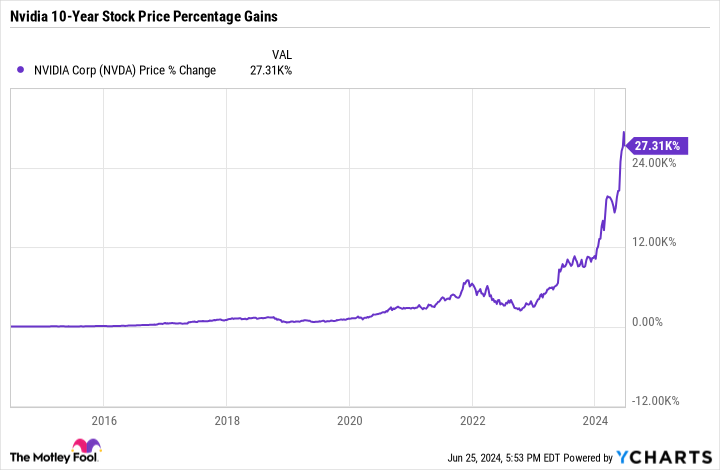Buying stocks in quality companies and holding them for years, if not decades, has proved to be the clearest path to wealth generation — but it’s easier said than done. Most investors buy with the intention of holding through the usual ups and downs that are part of stock ownership. Yet the real test comes when a stock plunges, as it inevitably does, and fair-weather investors head for the exits.
Take Nvidia (NASDAQ: NVDA) for example. The maker of graphics processing units (GPUs) has been a life-changing investment for long-term shareholders. The stock has gained more than 27,000% over the past decade. Put another way, investors who bought $1,000 worth of Nvidia stock 10 years ago are sitting on more than $274,000 — but traveling that path hasn’t been easy.
In fact, just two years ago, Nvidia stock plunged 66% from its high.

Two important lessons from history
In theory at least, holding stocks through a drawdown is relatively easy. Most investors talk a good game and absolutely mean to hang onto winning stocks when the going gets tough. However, it’s much more difficult in practice because emotions are involved. An illustration might help provide a little perspective.
In November of 2021, Nvidia was riding high. The start of the global pandemic in early 2020 and the stay-at-home orders that followed boosted demand for Nvidia’s processors.
Gaming enjoyed a resurgence, as both casual and serious gamers spent more time playing computer games. As the leading provider of high-end graphics cards used by gamers, Nvidia was among the biggest beneficiaries of this trend.
Personal computer (PC) sales also soared as people equipped their home offices to ride out the lockdowns working from home. This upgrade cycle also worked to Nvidia’s advantage. During that two-year period, Nvidia’s revenue climbed 129%, while its net income jumped 159%. This fueled stock price gains of 525%.
Then the bottom dropped out. Consumers changed their spending habits in the face of slowing economic growth and rising inflation. Tough choices in the grocery aisle and at the gas pump meant people had less spending money — and sales of gaming chips slumped. Sales of processors for cloud computing also crashed as businesses slashed spending, expecting the worst.
Between November 2021 and October 2022, Nvidia stock lost 66% of its value, the downward spiral fueled by spooked investors trying to lock in gains or prevent losses. Many investors who sold Nvidia resolved that they would buy the stock back at a lower price, but it rarely works out that way. Doubts remain, the bottom is missed, money gets invested in other, more appealing stocks, or time gets away from us. Before you know it, Nvidia stock costs way more than investors sold it for, and — thanks to price anchoring — many are reluctant to buy at this new, higher price.
This wasn’t the first time Nvidia shareholders had their mettle tested. Between September and December 2018, Nvidia’s stock price was cut in half. A cryptocurrency crash late that year caused demand for Nvidia GPUs to dry up. Used processors, which were once part of the cryptocurrency mining process, were being sold second-hand at dirt cheap prices, and Nvidia’s sales slumped.
This helps illustrate that Nvidia has been, and will continue to be, a volatile stock and trying to time the ups and downs of the market is a fool’s errand.
Hindsight is 20/20
As investors, we don’t usually have the advantage of hindsight, but history can be incredibly useful in helping inform our investing decisions.
For example, as a young investor who lived through the Great Recession in 2008 and 2009, I watched my entire portfolio lose as much as 41% of its value. This taught me that downturns are a natural part of the investing experience. These stock market swoons also represent a compelling opportunity to get quality stocks at discounted prices.
More importantly, I learned that when the inevitable recovery happens, my stocks will rebound and even reach new heights. There have already been countless investors who have learned this lesson in the wake of the recent bear market.
To be clear, watching my portfolio tank was painful, but I came to understand that these massive sell-offs are merely part of the cost of admission. So, when Nvidia stock plunged 66% a couple of years back, I was ready. I added the stock to my portfolio numerous times, getting Nvidia for a song.
The same thing was true during Nvidia’s crypto pullback in 2018 when the stock lost 52%. Sure, inventory levels were bloated and sales fell off a cliff. At the time, I reasoned that once the inventory cleared — as it no doubt would — demand would return, and Nvidia stock would rebound — and that’s precisely what happened.
The ability to use history as a guide is among the most valuable tools we, as investors, possess.
A costly lesson
Investors who sold Nvidia during previous slumps have paid a hefty price for that decision. Being scared out of one of the best-performing stocks of a generation would certainly hurt your results. Furthermore, Nvidia stock has declined more than 50% multiple times on the road to 27,000% gains.
Investors should be prepared for another Nvidia stock price decline of 50% or more. I have no doubt it’s coming. It may not be this week or even this year, but it’s coming. Furthermore, investors should resist the temptation to try to time the market and simply hold through the inevitable downturn that is sure to happen. The most important takeaway is to know that it’s coming and plan to react accordingly.
Volatility is part of the cost of admission for a successful investor, and those who master it reap the rewards.
Should you invest $1,000 in Nvidia right now?
Before you buy stock in Nvidia, consider this:
The Motley Fool Stock Advisor analyst team just identified what they believe are the 10 best stocks for investors to buy now… and Nvidia wasn’t one of them. The 10 stocks that made the cut could produce monster returns in the coming years.
Consider when Nvidia made this list on April 15, 2005… if you invested $1,000 at the time of our recommendation, you’d have $757,001!*
Stock Advisor provides investors with an easy-to-follow blueprint for success, including guidance on building a portfolio, regular updates from analysts, and two new stock picks each month. The Stock Advisor service has more than quadrupled the return of S&P 500 since 2002*.
*Stock Advisor returns as of June 24, 2024
Danny Vena has positions in Nvidia. The Motley Fool has positions in and recommends Nvidia. The Motley Fool has a disclosure policy.
What Would You Do If Nvidia Plunged 66%? History Suggests a Massive Decline is Coming. was originally published by The Motley Fool
Source Agencies


